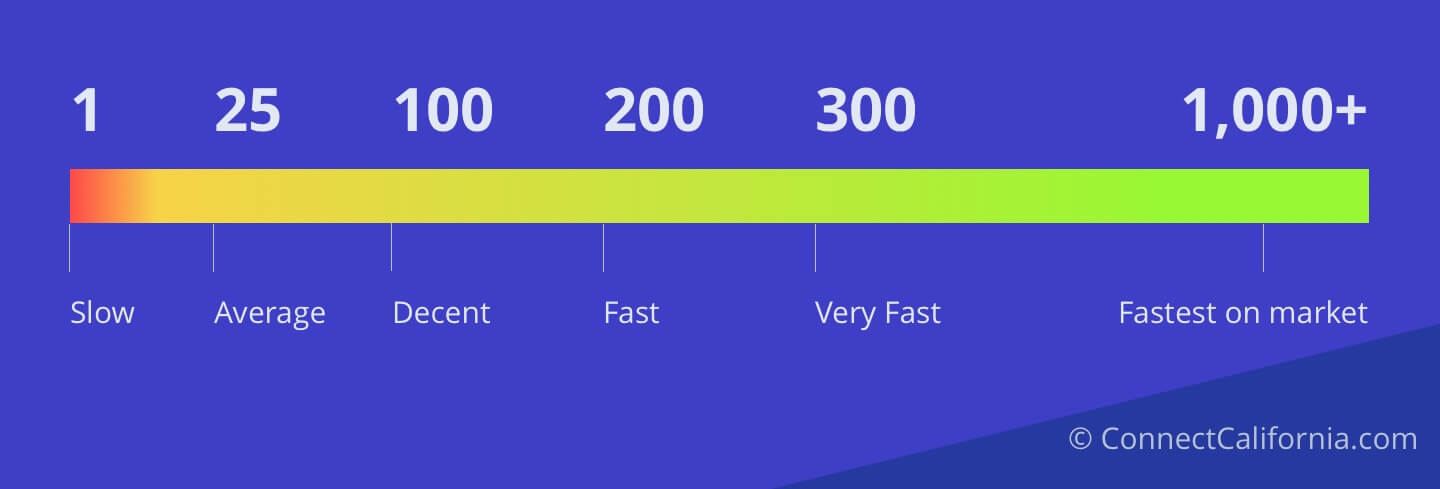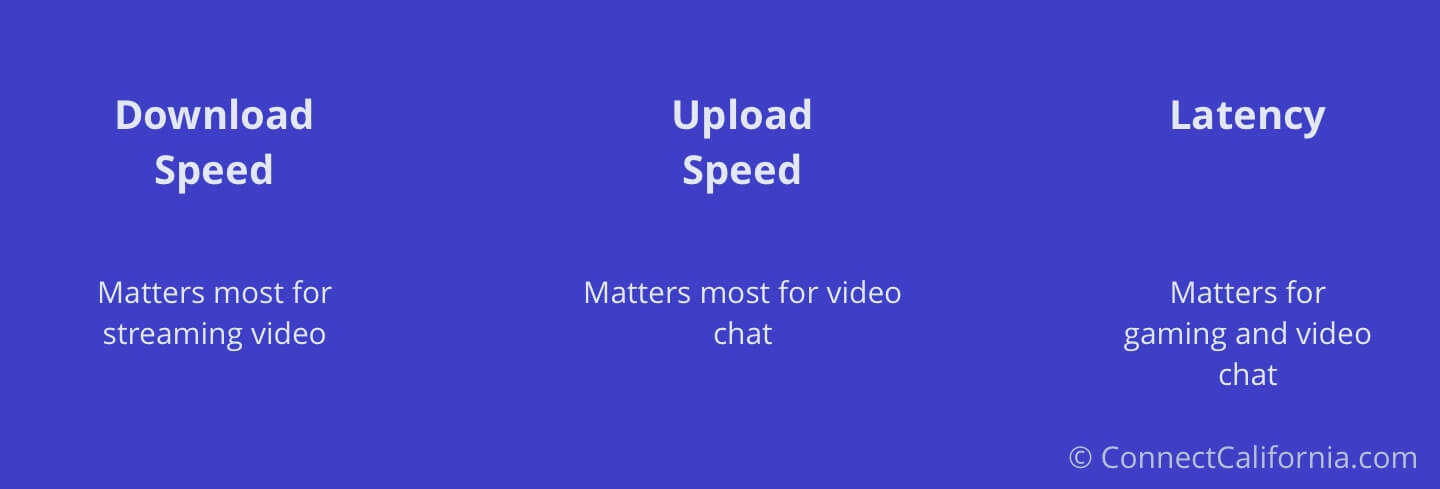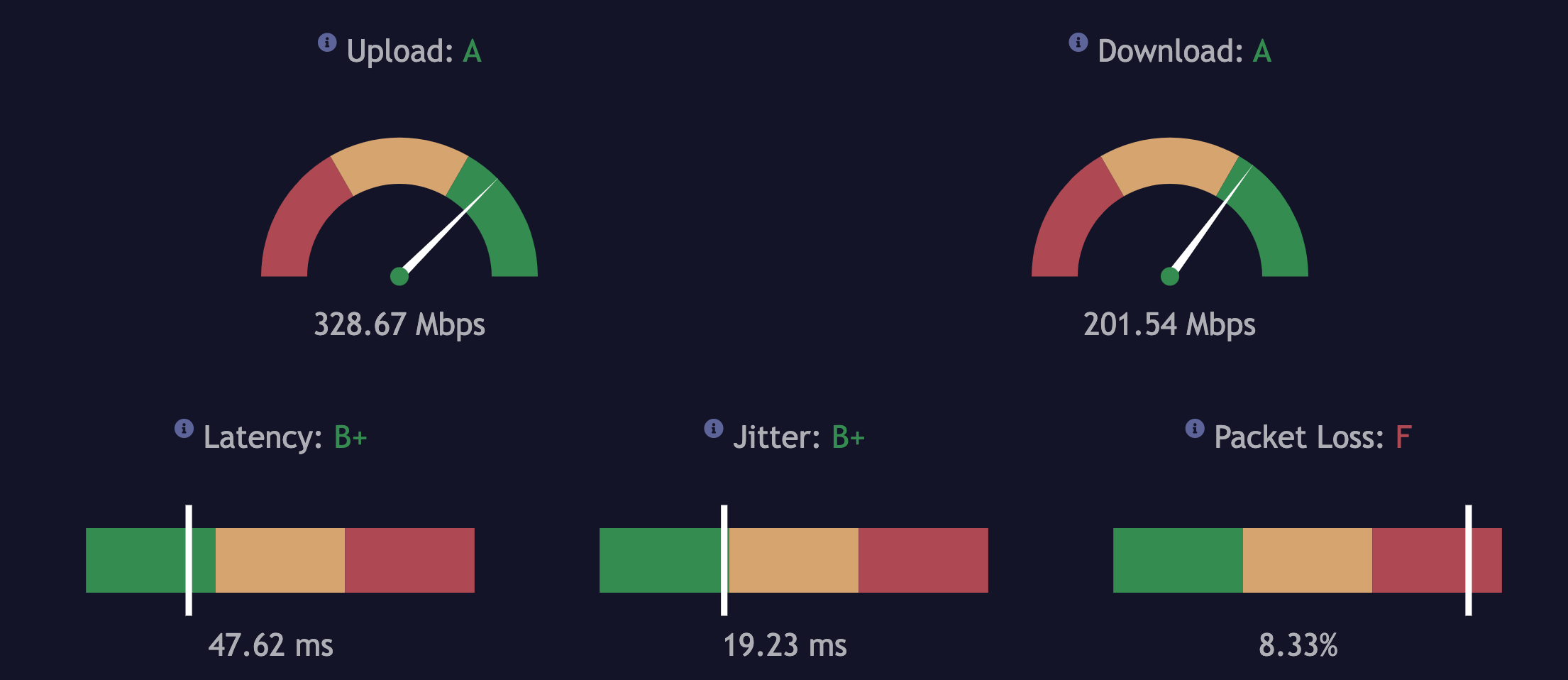Internet speeds are rising in 2024, and 300 Megabits per second (Mbps) is now one of the most common base speeds for cable and fiber internet plans.
Internet connections at 300 Mbps are considered “very fast.” Download speeds 300 Mbps and above can support moderate to heavy internet use by 2–5 people. 300 Mbps is considered mid-range for cable providers like Xfinity and Spectrum, and is a common base speed for fiber providers like AT&T and Ziply Fiber.

How much internet speed do I need?
Internet connections are measured on a scale from 0–1,000 Mbps. Anything below 25 Mbps is considered slow in 2024, although it was considered fast barely a decade ago.
Some providers like Google Fiber or Ziply Fiber offer more, but the vast majority of homes are limited to more normal speeds with 300 Mbps as a mid-range option.
Rural homes may be limited to plans under 1 Mbps, but this is also becoming rare as alternatives like satellite internet get better.
The most common issues with 300 Mbps internet connections have to do with Wi-Fi range and upload speed limits:
- Wi-Fi range: To ensure strong Wi-Fi, most customers should consider using their provider’s Wi-Fi equipment at the 300 Mbps level, since cheap third-party routers are prone to issues and fall outside provider service agreements.
- Upload speed limits: cable providers often provide 300 Mbps download with a lower 10–35 Mbps upload speed, due to limits on cable lines. Shop for an upload speed of at least 15 Mbps if you have more than one person working or studying from home.
Find internet providers near you
Enter an address to view internet companies in your area, ranked by speed and value.
Overall, 300 Mbps is a strong speed test result and is enough speed for the majority of homes.
The only users who should consider purchasing plans above 300 Mbps are those who have five or more heavy internet users in their household. People with home offices that work with large files may also consider plans above 300 Mbps; video production workers in particular will notice a difference in efficiency by increasing their upload bandwidth.
300 Mbps is overkill for a home of 2–3 people who mostly just watch Netflix and do the occasional video call or work-from-home day. These users can save money without reducing their experience by settling for a 50–100 Mbps plan.
Table of Contents
The article below will cover:
Internet speed terms and concepts
- Megabits per second (Mbps): The unit used to measure internet speed. 1–1000 Mbps is a normal range.
- Download speed: The speed at which your connection can move data from the internet to your home network.
- Upload speed: The speed at which your connection can move data from your home network to the internet.
- Latency: The lag between sending and receiving data over the internet.
- Jitter: The variation in lag for individual data packets; this will feel like “stutter” on video calls.

Is 300 Mbps good for gaming?
300 Mbps is enough for any PC gaming, and can download files from sources like Steam rapidly compared with an older DSL or basic cable connection.
The core issue with gaming on 300 Mbps is latency or ping, meaning the "lag" between your home network and the server running the game.
Even with 300 Mbps plans, it's common to see issues with latency that can drag down your performance.
See the screenshot below for an example of what this looks like. This internet connection is "fast"... but can still get choppy for games and calls since the speed doesn't matter if the packets are getting lost or delayed during a stream.

Upload vs download speeds on 300 Mbps plans
Internet plans advertised at 300 Mbps are generally advertising based on the download speed only.
The upload speed may be the same for fiber service, but it’s not guaranteed; on cable connections like Xfinity and Spectrum, the upload speed is almost always much lower.
In fact, even in 2024, the fastest upload speed possible on most residential cable connections is 35 Mbps. That’s just 11% of the speed advertised when you purchase a 300 Mbps internet plan.
The reason upload speed is often lower is because most users will use the download bandwidth quite a bit more than the upload bandwidth. Streaming Netflix, downloading files, working in Google Docs, scrolling Facebook; all these activities are “content consumption,” and you actually send very little data “upstream” during normal use.
The big outlier here is video chat. The bandwidth needed for a Zoom or Facetime call varies from 0.6–1.5 Mbps, but can go up to 2–3 Mbps, and runs into issues if you’re already sending lots of other data streams through a low-bandwidth connection over Wi-Fi.
If you work from home or study from home, getting an upload speed of at least 10–15 Mbps is strongly suggested. Lower than 10 Mbps will likely give you issues with calls and streams, especially if you have a lot of smart home devices or a security camera on the same connection.
AT&T’s cheapest plan has a 300 Mbps download and upload speed, making it a good example of a smart home-friendly plan.
A summary of each common internet speed level
25 Mbps
25 Mbps is a common entry speed result for DSL and cable internet connections throughout the US.
25 Mbps is, conveniently, the government’s official definition of “high speed” broadband internet. (Although California’s broadband definition oddly sets the bar even lower at 10 Mbps.)
This speed level is enough for 1–3 people who don’t use the internet too heavily. A couple with one kid can be happy on this speed tier, unless they have a 4K TV. Anyone who works from home, studies from home, or otherwise regularly needs video chat and extra bandwidth is likely to be frustrated with 25 Mbps — especially when they see 40–50% less than that on their speed tests due to Wi-Fi lag.
100 Mbps
100 Mbps has become a very common base plan level for urban and suburban cable providers like Spectrum and Cox.
100 Mbps is enough for homes with 2–3 users, and can support a 4K TV easily.
The main issue users see on 100 Mbps tends to be related to upload speed, since cable plans often have lower upload speeds that download. This is confusing for customers who buy a “100 Mbps” plan and expect the same speed for uploading files and streaming, only to find a 5–35 Mbps cap.
500 Mbps
500 Mbps plans and speed test results are most common for fiber internet plans like Google Fiber, AT&T Fiber, and Sonic Fiber.
To be honest, if you’re reading this far, you probably are not the target audience for plans above 500 Mbps. The difference between 500 Mbps and 1,000 Mbps will rarely be felt during normal daily use, and only really matters for homes with large and complex smart home setups, home theater systems, home offices, and other “power user” setups.
1000 Mbps
1,000 Mbps or “gigabit” internet plans are a popular high-end option with both cable and fiber providers including Xfinity and AT&T. This speed is sometimes called 1 Gigabit or 1 Gig, which is just a different way of counting the bandwidth.
It’s important to note that most fiber plans advertising this speed actually have equipment that tops out around 940 Mbps for download and 840 Mbps for upload. Still extremely strong speeds, but you may be confused when you run speed tests and see results in the 600–900s.
Cable providers like Xfinity offering 1,000 Mbps plans are a bit misleading in that the upload speed offered is much lower. As with other speed tiers, the maximum you’ll see on most cable plans in 2024 is in the 35–100 Mbps range.
For context, that’s enough to handle 2–3 video calls at once, but not nearly the level of upload service provided by a true fiber to the home internet service.
1–2+ Gbps
Just a year ago, 1,000 Mbps was more or less the hard limit on residential internet plans. This speed tier was only available from select fiber providers like Google Fiber or Ziply Fiber, and came with a higher price tag.
Thanks to new fiber technology, that’s starting to change. AT&T and Sonic have both launched multi-gigabit services in areas like San Francisco and Los Angeles.1
Frequently Asked Questions
Is 300 Mbps a fast internet speed?
300 Mbps is considered very fast. It is a good plan tier for homes with 2–5 users assuming regular use like streaming video, video chat, and casual browsing. The core issue with most 300 Mbps plans is the upload speed. Cable providers often have lower upload speeds in the 5–35 Mbps range for plans advertised at the 300 Mbps download speed.
Is 300 Mbps internet worth it?
300 Mbps internet is worth it if you have a 4K widescreen, frequently work from home, or have 3+ people using video chat at the same time during a normal day. Homes with fewer than 4 people are should consider saving $20–30 per month by choosing a cheaper plan in the 50–200 Mbps range.
Is 300 Mbps good for gaming?
300 Mbps internet is good for gaming, but can still have issues with ping, latency, and jitter just like a slower plan. 300 Mbps is only worth it as an upgrade option if you also do a lot of streaming, specifically streaming your games on Twitch or similar platforms. In these cases, the increased upload bandwidth can be useful enough to justify a higher monthly cost.



